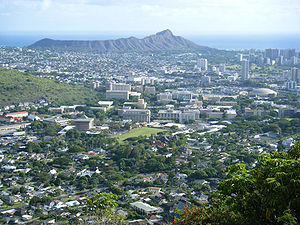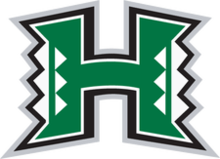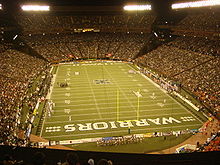历史
The University of Hawaiʻi at Mānoa was founded in 1907 as a land grant college of agriculture and mechanical arts. In 1912 it was renamed the College of Hawaiʻi and moved to its present location. William Kwai Fong Yap petitioned the territorial legislature six years later for university status which led to another renaming to the University of Hawai'i in 1920. This is also the founding year of the College of Arts and Sciences.
In 1931 the Territorial Normal and Training School was absorbed into the university. It is now the College of Education.
College

Manoa campus with Diamond Head from Round Top Drive
Today the primary facet of the university consists of the four Colleges of Arts and Sciences: Arts and Humanities, Languages Literatures and Linguistics, Natural Sciences, and Social Sciences. The college of agriculture and mechanical arts is now the College of Tropical Agriculture and Human Resources (CTAHR), one of the few agricultural colleges in the United States focused on tropical research. The University of Hawaiʻi at Mānoa is also home to two of the most prominent professional schools in the state. The William S. Richardson School of Law and the John A. Burns School of Medicine are the only law and medical schools in Hawaiʻi, respectively. The Center for Hawaiian Studies provides 'excellence in the pursuit of knowledge concerning the Native people of Hawaiʻi' [1].
Together, the colleges of the university offer bachelor degrees in 87 fields of study, master degrees in 87 fields, doctoral degrees in 53 fields, first professional degrees in three fields, post-baccalaureate degrees in three fields, 29 undergraduate certification programs and 26 graduate certification programs. Total enrollment as of 2006 was 20,357 students, 14,307 of which are undergraduates. There are approximately sixteen students per instructor.
Research
With extramural grants and contracts in excess of $300 million in 2002-03, UH-Manoa exploded in terms of research related to Hawaii's physical landscape, its people, and their heritage. The landscape facilitates advances in marine biology, oceanography, underwater robotic technology, astronomy, geology and geophysics, agriculture, aquaculture and tropical medicine. Its heritage, the people and its close ties to the Asian and Pacific region create a favorable environment for study and research in the arts, genetics, intercultural relations, linguistics, religion and philosophy.
Extramural funding increased from $211 million in FY 2002 to nearly $255 million in FY 2003. Research grants increased from $125 million in FY 2002 to $165 million in FY 2003. Nonresearch awards totaled $90 million in FY 2003. Overall, extramural funding has increased by 50% over the past ten years. Princeton Review and The National Science Foundation ranks UH Manoa in the top 30 public universities for federal research funding in engineering and science
The School of Ocean and Earth Science and Technology (SOEST) received the largest amount of extramural funding among the Manoa units at $60 million. SOEST was followed by the John A. Burns School of Medicine (JABSOM) at $41 million, the College of Natural Sciences at $24 million, the Institute for Astronomy at $22 million, the Pacific Basin Research Center at $21 million, the College of Education at $19 million, and the Cancer Research Center of Hawai‘i at $18 million.
Systemwide, the majority of research funding comes from the Department of Defense, the Department of Health and Human Services, the National Science Foundation, the Department of Commerce, and the National Aeronautics Space Administration (NASA). For nonresearch grants, the majority of funding comes from Hawai‘i government agencies, the Department of Education, the National Science Foundation, Hawai‘i health organizations, and NASA.
The new $150-million medical complex in the area of Kaka‘ako opened in the spring of 2005. The facility houses a state-of-the-art biomedical research and education center that attracts significant federal funding and private sector investment in biotechnology research and development.
UH Manoa is characterized by a wealth and variety of research projects. Research broadly conceived, is expected of every faculty member at UH Manoa.
Rankings
|
|
This section does not cite any references or sources.
Please help improve this article by adding citations to reliable sources. Unsourced material may be challenged and removed. (May 2009) |
Owing in part to world-renowned marine laboratories located off the main campus, the University of Hawaii is very active in the marine sciences. According to The Academic Analytics, UH's graduate programs are ranked as follows: 2nd in Oceanography, 4th in Marine Science, 7th in Geophysics, and 8th in Epidemiology.
The International Business program, in the Shidler College of Business, is ranked 21st by US News and World Reports and Shidler College of Business ranks among the top 20 undergraduate business schools in the 2008 as of U.S.News & World Report.
Teacher Education is ranked 6th by The Academic Analytics.
The John A. Burns school of medicine, the Medical School of the University of Hawaii, is ranked 12th in the nation for geriatrics.
Other Highlights: Named a "Best Western College" and a "America's Best Value College" by Princeton Review but was dropped in the 2009 edition.
Richardson School of Law ranks in the top 20 for environmental law, diversity, and low student/faculty ratio according to U.S.News & World Report: America's Best Graduate Schools 2008. It is also the smallest law school within the top 100 law schools, and in the top 40 for first-time bar passage rate and lowest student debt. It's also ranked third in "Best Environment for Minority Students," and fifth for "Most Diverse Faculty"
U.S.News & World Report ranks the Library and Information Science program, school library media specialization, among the top 10 in the nation
Diversity
According to the 2003 report of the Institutional Research Office, a plurality of students at the University of Hawaiʻi at Mānoa are Caucasian making up twenty-four percent of the student body. Japanese Americans represent twenty percent, Chinese Americans represent nine percent, Filipino Americans represent eight percent as do native Hawaiians. Ten percent of the student body are racially mixed. Smaller populations of Pacific Islanders and other ethnic groups make up the remainder.
学术
Colleges and schools
University of Hawaii at Manoa has 19 schools and colleges, including the School of Architecture, School of Earth Science and Technology, the College of Arts and Humanities, the Shidler College of Business, the College of Education, and the College of Engineering. The College of Business Administration was renamed the Shidler College of Business on September 6, 2006, after real estate executive Jay Shidler, an alumnus of the college, donated $25 million to the college.
Library
The Library, which provides access to 3.4 million volumes, 50,000 journals, and thousands of digitized documents, is one of the largest academic research libraries in the United States, ranking 86th in parent institution investment among 113 North American members of the Association of Research Libraries.
Student life
Student organizations
- Graduate Student Organization
- Associated Students of the University of Hawaii
- Broadcast Communication Association
- Board of Publications
- Campus Center Board
- Student Activity and Program Fee Board
- National Society of Collegiate Scholars
- Golden Key International Honour Society
- Alpha Gamma Delta
- Beta Beta Gamma
- Kappa Epsilon Theta
- Kappa Sigma
- Tau Kappa Epsilon
- Student Farm S.O.F.T.
|
Student government
The Associated Students of the University of Hawaiʻi (ASUH) is the undergraduate student government representing all full-time, classified, and undergraduate students at the University of Hawaiʻi at Mānoa. ASUH was chartered by the University of Hawaiʻi Board of Regents in 1912 and is now in its 97th year of serving and representing students. ASUH strives to serve students by advocating on their behalf with various entities, including the university administration, faculty, staff, community groups and government officials. ASUH also serves students by utilizing ASUH student fee money to fund diversified student programs and events on-campus.
Ka Leo O Hawaiʻi
Ka Leo O Hawaiʻi is the student newspaper at the University of Hawaiʻi at Mānoa, founded in 1922 (as The Mirror). The Ka Leo is now printed three times a week (Monday, Wednesday, Thursday), and weekly during the winter and summer breaks. Page length is normally 8 pages, tabloid format. Circulation is approximately 7,000. Beginning in the Fall 2007 semester the Ka Leo is now printed in full color.
Off-campus
- The Newman Center / Catholic Campus Ministry serves the community at the University and surrounding area.
- The Lyon Arboretum serves as the only tropical arboretum belonging to any University in the United States. The Arboretum, located in Manoa Valley, was established in 1918 by the Hawaiian Sugar Planters' Association to demonstrate watershed restoration and test various tree species for reforestation, as well as collect living plants of economic value. In 1953, it became part of the University of Hawaiʻi at Manoa. Its over 15,000 accessions focus primarily on the monocot families of palms, gingers, heliconias, bromeliads, and aroids.
- The Waikiki Aquarium, founded in 1904, is the third oldest public aquarium in the United States. A part of the University of Hawaii since 1919, the Aquarium is located next to a living reef on the Waikiki shoreline.
体育运动
Main articles: Hawaii Rainbow Warriors and Hawaii Rainbow Wahine
See also: Hawaii Warriors football

University of Hawaii's Athletic Logo.
The University of Hawaiʻi at Mānoa competes in NCAA Division I, the only Hawaiʻi school to do so. In major sports, it competes in the Western Athletic Conference. In men's volleyball and women's water polo it competes in the Mountain Pacific Sports Federation, and the men's swimming and diving team have been invited the two last years to compete in the Conference USA Invitational meet.

The off-campus Aloha Stadium, situated near Pearl Harbor in Honolulu has been the home of Warrior Football since 1975.
The men's teams were formerly known as the Rainbow Warriors but in 2000, in response to complaints from the football program that the rainbow was a symbol of homosexuality, the University of Hawaiʻi at Mānoa athletics program allowed each sport to select their own team names. The current situation is rather confusing; various men's teams are called the Warriors, the Rainbow Warriors, or the Rainbows. The men's volleyball team chose the name Men of War, but that name proved to be unpopular and was replaced by the Warriors.
The women's teams are called the Rainbow Wahine. This name is often shortened to The Rainbows or The 'Bows.
The Warriors and Rainbow Wahine are most notable for their highly-ranked men's and women's basketball, volleyball, baseball and football programs. The University also won the 2004 Intercollegiate Sailing Association National Championships. The women's volleyball program has won NCAA championships in 1982, 1983 and 1987. The men's volleyball won an NCAA championship in 2002, but it was later vacated due to violations.
The principal sports venues are Aloha Stadium, Stan Sheriff Center, Les Murakami Stadium, Rainbow Wahine Softball Stadium, and the Duke Kahanamoku Aquatic Complex.
The universities athletic budget in FY 2008-2009 is $29.6 Million [2].
[edit] Chancellors
From 1986 to 2001, the President of the University of Hawaiʻi system also served as the Mānoa campus's chancellor. In 2001, the position of Chancellor was recreated by then-UH president Evan Dobelle after several years of discussion around the possible conflict of interest that might arise in this dual role (being the president of a University system while concurrently being the chancellor of a specific campus within the system).
- Virginia Hinshaw 2007-current
- Denise Konan 2005-2007
- Peter Englert 2002-2005
- Deane Neubauer 2001-2002 interim
- University president 1986-2002
- Kenneth P. Mortimer
- Albert J. Simone
Notable alumni & faculty
See University of Hawaiʻi page.
Art on campus
Campus art includes:
- The John Young Museum of Art
- The Jean Charlot collection at the Hamilton Library
- Murals by Jean Charlot: The Relation of Man and Nature in Old Hawaiʻi (1949), Commencement (1953), Inspiration, Study, Creativity (1967), and Mayan Warrior (1970)
- Sculptures by Edward M. Brownlee: Maka ʻIo (Hawk’s Eye) (1984), and an untitled reflecting pool with copper and iron sculpture (1962)
- Sculptures by Bumpei Akaji: Maka ʻa e ʻIke Aku i ke Awawa Uluwehi i na Kuahiwi o Manoa (Glowing Eyes Looking at the Lush Valley in the Mountains of Manoa) (1979), Manaʻoʻiʻo (Confidence and Faith) (1981), and VVV (1995)
- Murals by Mataumu Toelupe Alisa: Backyard Cooking (1977), and Hula (1982)
- Works by Shige Yamada: ʻAlae a Hina (Mud Hen of Hina) (1977), and Rainbows (1997)
- Sculptures by Greg Clurman: Sumotori (Sumo Wrestler, 1975), and Hina o na Lani (Mother of the Universe, 1975)
- Wa (Harmony), ceramic sculpture by Wayne A. Miyata, 1982
- Founders’ Gate, stone arches by Ralph Fishbourne, 1933
- Neumes o Hawaiʻi, ceramic tile bench and planter by Suzi Pleyte Horan, 1976
- Chance Meeting, cast bronze sculpture by George Segal, 1991
- Three untitled murals by Frank M. Moore, 1919
- Silent Sound, brass bas relief by Paul Vanders, 1973
- The Net Effect, cast bronze sculpture by Fred H. Roster, 1982
- Rainbow Spirit, painted copper sculpture by Babs Miyano-Young, 1997
- Untitled ceramic wall sculpture by Isami Enomoto, 1964
- Gate of Hope, red-orange painted steel sculpture by Alexander Liberman, 1972
- Divers, red brass sculpture by Robert Stackhouse, 1991
- Krypton 1 x 6 x 18, mixed media monolith by Bruce Hopper, 1973
- Wisdom of the East, fresco by Affandi, 1967
- Pulelehua (Kamehameha Butterfly), ceramic mural by Bob Flint, 1986
- Makahiki Hoʻokupu (Harvest Celebration), charcoal and sanguine mural by Juliette May Fraser, 1938
- Nana i ke Kumu (Look to the Source), batik triptych by Yvonne Cheng, 1978
- GovDocs, mural by Judith Yamauchi, 1982
- ʻAnuenue #2 (Rainbow #2), three-part woven wall hanging by Reiko Brandon, 1977
- Seated Amida Buddha, 15th century Japanese wood sculpture with gold over black lacquer
- Epitaph, bronze, steel and granite sculpture by Harold Tovish, 1970
- Grid/Scape, terrazzo and aluminum landscape sculpture by Mamoru Sato, 1982
- The Great Manoa Crack Seed Caper, by Lanny Little and student assistants, 1981
- The Bilger Frescoes representing Air, Water, Earth and Fire by Juliette May Fraser, David Asherman, Sueko Matsueda Kimura and Richard Lucier, 1951-1953
- The Fourth Sign, painted steel sculpture by Tony Smith, 1976
- Varney Circle Fountain, by Henry H. Rempel and Cornelia McIntyre Foley, 1934
- Spirit of Loyalty, cast glass sculpture Rick Mills, 1995
- Mind and Heart, metal sculpture by Frank Sheriff, 1995
- To the Nth Power, steel sculpture by Charles W. Watson, 1971
- Bamboo Forest, mural painted on bricks by Padraic Shigetani, 1978
- Peace Pole, painted obelisk, 1995
- Hawaiʻi Kaʻu Kumu (Hawai‘i My Teacher), pair of murals by Calley O'Neill and assistants, 1982
- Untitled painted photorealist mural by Donald Yatomi, 1990
- Arctic Portals, stainless steel sculpture by Jan-Peter Stern, 1975
- Adam, bronze sculpture by Satoru Abe, 1954
Maps and a suggested route for a campus art tour may be found at this website
These artworks are off the main campus:
- East-West Center gallery
- Pleiades, overhead installation of mounted prisms at the Institute for Astronomy by Otto Piene, 1976
- Shadow of Progress mixed media sculpture at the Pacific Biomedical Research Center by Rebecca Steen, 1990
- Woven wall hanging at KHET (2350 Dole Street) by Jean Williams, 1972
Other points of interest
- Japanese garden with koi pond and teahouse
- The Sala, a Thai open pavilion
- Hawaiʻi Peace Memorial, granite monument commemorates Japanese immigration to Hawai‘i
- Hawaii Warriors football
- Hawai`i Institute of Marine Biology
- Hawaii Ocean Time-series (HOT)
- The John Young Museum of Art
- Manoa Stream
- Haniwa, reproduction of a 3rd–7th century Yayoi period Japanese burial mound marker
参考文献
- ^ "Honolulu CDP, HI." U.S. Census Bureau. Retrieved on May 21, 2009.
- ^ The Gift
- ^ ARL Statistics 2007-08 (page 94)
External links
- University of Hawaiʻi System
- University of Hawaiʻi at Mānoa
- University of Hawaiʻi Mānoa Athletics
- Ka Leo O Hawaiʻi student newspaper
- Student Housing Student Housing
- University of Hawaii Infrasound Laboratory
- ScholarSpace institutional repository
- University Archives Archives & Manuscripts Department, University of Hawaii at Manoa Library
| UH |
|
Mānoa • Hilo • West Oʻahu
|
Universities |
|
Hawaiʻi • Honolulu • Kapiʻolani • Kauaʻi • Leeward • Maui • Windward
|
Community Colleges |
|
John A. Burns School of Medicine • William S. Richardson School of Law
|
Post-Grad |
The University of Hawaiʻi Ma luna aʻe o na lahui a pau ke ola ke kanaka
v • d • e
|



